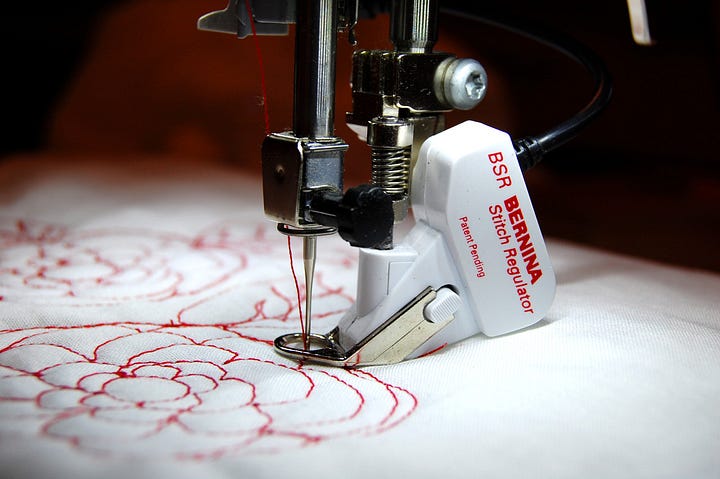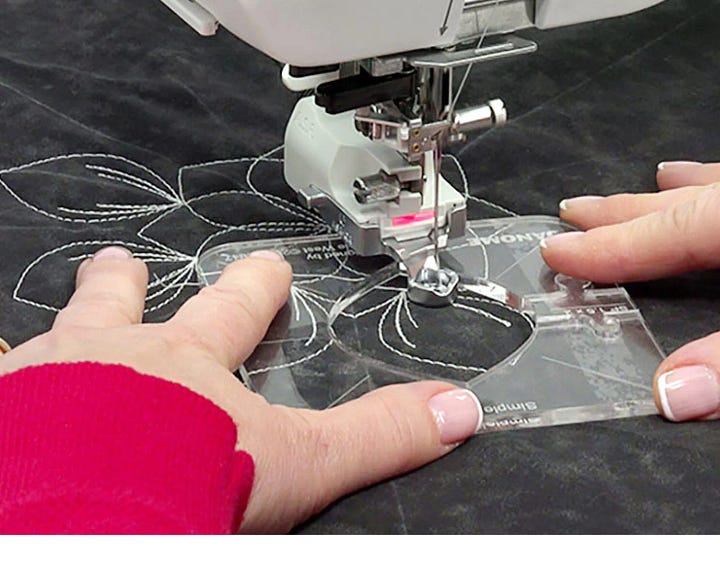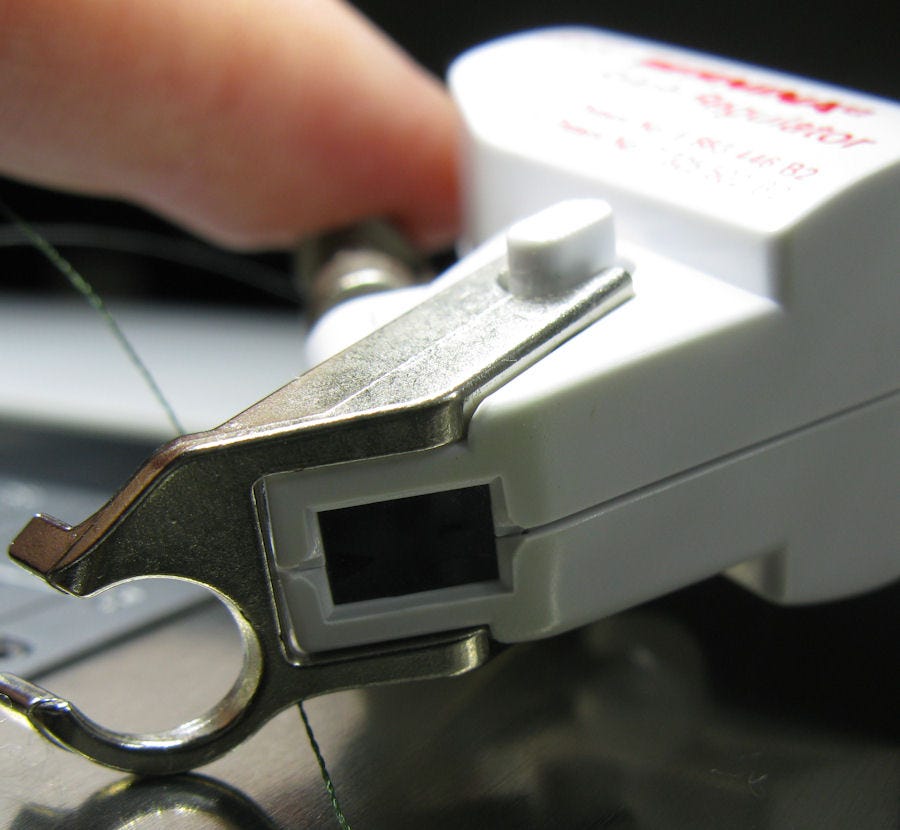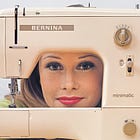Greetings everybody,
Today I want to talk about a technology that has had a massive impact on the sewing machine landscape: the stitch regulator.
What is it? Why would one want/need to use it? What machines are compatible with a stitch regulator?
I will discuss all that and more. I hope you find it interesting.
—Cale
Free-Motion Sewing
The stitch regulator is an accessory one would use during free-motion sewing.
With regular sewing, the direction the fabric is fed is determined by the action of the feed dogs, which feed the fabric forward and backward a designated length each stitch. With free-motion sewing, the sewist disengages the feed dogs on her machine so that they remain below the needle plate and do not feed the fabric whatsoever. Instead of the feed dogs feeding the fabric forward, the sewist moves the fabric manually with her hands.
The benefit of free-motion is that the direction of the fabric is not limited by the ability of the feed dogs. With the feed dogs are disengaged, the user can move the fabric in any direction she wants— forwards, backwards, diagonally, side to side. This technique allows sewists— especially quilters— to create incredible designs and textures on their work that we couldn’t otherwise achieve with a typical straight stitch. It allows for a certain level of improvisation and increased creativity while quilting.

Challenges of Free Motion
The difficulty of free-motion is that it is a challenge to achieve consistent stitch length.
With regular sewing, stitch length is controlled by the gripped feed dog teeth. If we set our stitch length to 2 millimeters, then the feed dogs will feed the fabric 2 millimeters between every stitch. If we set our stitch length to 3.5 millimeters, then the feed dogs will feed the fabric every 3.5 millimeters. And so on.
With free-motion, because we disengage the feed dogs while sewing, stitch length is controlled by the user, not the machine. If I want the stitch length to be 2 millimeters, then I have to manually move the fabric 2 millimeters between stitches. As you can imagine, precision and consistency are difficult.
Because I am an imperfect being, it is impossible for me to consistently move fabric precisely 2 millimeters between every stitch, especially with a machine that sews at a speed of 400-800 stitches per minute. The task becomes even more difficult when I try to do curves and turns on a large swathe of fabric like a quilt, where I am prone to accidentally jerk the fabric and end up with random bouts of 5 millimeter stitch length when I am trying to execute a stitch length closer to 2 millimeters.

On top of that, free-motion is also challenging because we are more susceptible to flagging, which increases our chances of skipped stitches.
Sewists don’t like skipped stitches. They don’t like inconsistent stitch length.
Enter, the stitch regulator.
The Stitch Regulator
A stitch regulator is a device that detects how fast the fabric is being moved underneath the presser foot and then adjusts the speed of the needle going up and down accordingly in order to achieve a consistent stitch length.


With regular free-motion, in order to achieve consistent stitch length the user must move the fabric at a speed that is proportionate to the speed that the needle is moving up and down. With a stitch regulator you don't need to worry about how fast you move your fabric during free motion, nor do you need to worry about how fast you are running the machine. Put your foot all the way down on the foot pedal— even if it is all the way down, pedal to the metal, the needle will move very slowly.
How does this work?
The sensor of the stitch regulator senses the movement of the fabric, and communicates that speed to the machine. Based on the speed that the fabric is moving (and the desired stitch length and that you select on the machine’s screen), the machine will either speed up or slow down. Move the fabric faster, then the needle moves faster. Move it slower and the needle moves slower. Stop moving the fabric and the machine stops sewing.
Note: If you select a shorter stitch length, the machine will turn over faster than it would if you had selected a longer stitch length; e.g. the frequency between stitches will be longer at 4mm stitch length vs 1mm stitch length.
While the stitch regulator is an incredibly helpful tool for achieving precise stitch length during free-motion sewing, it is not perfect. If you move the fabric super fast and in a jerky motion, you can still get skipped stitches and inconsistent stitch length. It does not fix the problems one experiences when sewing with a bent needle. It does not overcome poor-quality thread.
In my opinion, in order to achieve the best results possible with a stitch regulator, you ought to sew as if you don’t have a stitch regulator. If you get lazy and jerk the fabric around, problems may still occur. Try your best to move the fabric evenly and at a consistent speed, and the stitch regulator will make up for human error.
What Machines Are Compatible With A Stitch Regulator?
For a long time, Bernina was the only company to offer home sewing machines with stitch regulation capability. If I am not mistaken, the Bernina Aurora 440 was the first machine equipped with BSR (Bernina Stitch Regulator) when it was released about 15-20 years ago. These days, most Bernina 4-series, 5-series, and 7-series machines are all compatible with BSR. However, only a few models include the stitch regulator with purchase of a new machine. If the machine doesn’t come with a BSR but is compatible with one, then you can purchase a BSR new for roughly $800-1,000.
Bernina is no longer the only company to offer stitch regulation. Janome now offers their patented ASR (Accurate Stitch Regulator) on three of their machines: the Continental M17, Continental M8, and Memory Craft 9480.
You will also see long-arm quilting machines with stitch regulation. Juki makes a relatively cost-effective long-arm machine— the Miyabi J-350— which is designed with direct-drive technology and stitch regulation where the sensor is built into the needle plate. Bernina also makes an absolutely beautiful long-arm machine, the Bernina Q-Series (Q-16, Q20, Q24), which is one of the only machines still made in their factory in Switzerland.
Note: Brother and Baby Lock recently released their new top-of-the-line sewing & embroidery combination machines— Brother Aveneer & Baby Lock Radiance—both of which come equipped with stitch regulation.
Thank you for reading!
I hope this article offered a clear explanation of stitch regulation and why it is helpful for free-motion sewing.
Please feel free to share with your fellow sewists, or leave a comment in the comment section.
Thank you,
— Cale







Interesting article. I understand why stitch regulators may be desirable for quilting, where an even appearance to the stitching is required. For creative free-motion embroidery however, they would be a drawback. Sometimes you want the stitches to be different lengths as it's this that produces varying textures. Indeed it's the skill of the sewist that produces the varying textures as they alternate speed of the machine with movement of the fabric.
How can we get teenage educators to understand that the mechanics of a sewing machine share much in common with the engineering in prosthetic limbs? Some years ago our local tv news broadcast that a child needing a prosthetic arm would wait years on the NHS so a local engineer built her one from sewing machine parts. We seem to be desperately short of sewing machine engineers and it would be great to give them some glamour!